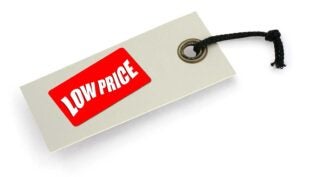Home > Finance > Pricing Strategy >
How to Protect Gross Margin with a Service Business
By: Dawn Fotopulos

These great questions were asked by Clyde Gooden of Geeks or US who is trying to figure out how profitable a client is.
How do I account for opportunity costs? More specially, how do I account for travel time when I drive to a client location? COGS? What dollar value do I assign to this?
This is such a great question. When you’re in a service business your cost of goods sold is really your cost of sales or the value of your time since you don’t have a physical product. As you know, I talk about this in the first few chapters of Accounting for the Numberphobic; A Survival Guide for Small Business Owners.
First figure out how much you charge per hour when you’re working for a customer and for what services. That’s your hourly rate. In a way, your business model is a lot like a lawyer or an accountant that charges for their time by the hour.
Since you live in Kansas City, your customer base is probably more geographically spread out than if you lived in say, New York City.
You have a few choices. I wouldn’t suggest charging per mile because that covers distance not time. Your time, as you suggest, is more valuable.
You might limit your clients to within a specific geographic area to limit drive time.
Contractors typically do this because they have the same problem you do; if they’re not on a job, they’re not generating revenues so they stay hyper-local to minimize travel time.
Is half an hour the limit from your office to the client? You decide.
Unlike a contractor, you also have the flexibility to be a remote help desk if the client is willing to give you remote access. I have that with my IT guy.
He does have to come to my office periodically, but not every time I have a systems glitch.
You could charge more (20-50%) for a site visit therefore providing an economic incentive for people to choose remote help.
Apply your working hourly rate to the time it takes you to get to a customer to decide if you’re making a good return for your time.
If that customer hires you on a retainer basis to do monthly maintenance, they generate predictable revenue streams and that may be worth making some time sacrifice to get the predictable monthly revenues.
How to Figure Out if A Customer is Profitable
The other thing you need to look at is if a client has referred other business to you. If they have, you might waive the travel costs because they’ve saved you in marketing expense (as a “thank you”).
One last option is to not charge if the commute is under X minutes, but charge half rate if it’s over that just to acknowledge your time is worth something.
If you have enough business within a short driving distance, commute time becomes negligible. Consider too the importance of the client to your total revenue stream.
If they’re a big client, you will want to make concessions. Just make sure you get something for it. Here are some suggestions:
- Have them write a great review of you on Angie’s List.
- Have them refer you to a colleague for new business.
- Have them refer you as a speaker to their small business organization as a speaker for you to get exposure to new business.
Never give something away without receiving some value back. It may not always come in the form of income, but it could come in the form of something that leads to income and revenue growth.
My objective is to see if I’m making a profit with a given customer. It’s not just how much time but the nature of the work you’re doing for a client.
Pricing Strategy for a Service Business
Do you charge just for time to do a full installation of new equipment?
Do you charge the same amount to do software upgrades or to install security firewalls?
Maybe it’s time to segment your services and charge different rates for different levels of skills and knowledge required. That’s another way to maximize your total return per client.
How to Maximize Revenues By Offering High Value Services
You could also be the IT 911 guy. Any time of the day or night, you’re there. And you charge a premium to be available at odds hours.
But you know and I know that systems and tech have a nasty way of breaking down at midnight when you’re in the middle of a big project.
You’d charge for travel time and a premium for your work time.
Pricing should include your hourly value plus a premium. If you don’t know what that is in your market to your audience, go out into the marketplace as a buyer of your type of services.
See what competition’s charging. Your fees should include a 20% premium to cover operating support costs like legal fees, accounting fees, supplies, website maintenance and software subscriptions.
If I owned a product based-business, the product is either being shipped and/or the customer is coming to me. This cost would show up in rent, utilities and employee cost to name a few.
However, as an on-site computer repair business, the true cost is not showing up on the books. Yeah, I have mileage but this doesn’t really show all of my costs.
Figure out how much it costs you by month to support the business. Your bookkeeper can help here. See the list of support services I listed quickly up above.
If you’re renting office space, include that as well as energy expenses and insurance costs. That gives you a full view of what it costs you to keep your doors open whether you have one client or a hundred clients.
Do I assign a dollar value for a round trip to a client location? If so, what would the new ratios be? Again, the dollar value of travel time has to do with what you’re average time value is per hour.
If you had someone come to your home to do your hair for a wedding, it’s always more expensive than going to the shop. People should expect to pay more.
It’s a tremendous convenience for someone like you to be available. Again, see what competition is doing and what they’re offering for what they’re charging.
My guess is, they charge for drive time at half the normal hourly rate if drive time goes beyond a certain threshold. Every micro market is different. In NYC, we get charged for everything and then some…
I hope this helps to answer your small business questions, Clyde.
We so appreciate these thoughtful questions. Hopefully, the answers will help many other service providers. If you want more details, be sure to buy Accounting for the Numberphobic; A Survival Guide for Small Business Owners.
It provides key details that will be the key to your small business survival.
This article was originally published by Best Small Biz Help
Published: December 5, 2014
2742 Views
2742 Views












